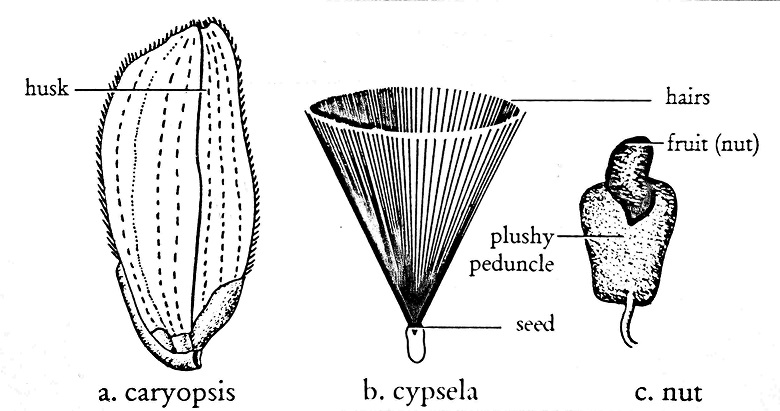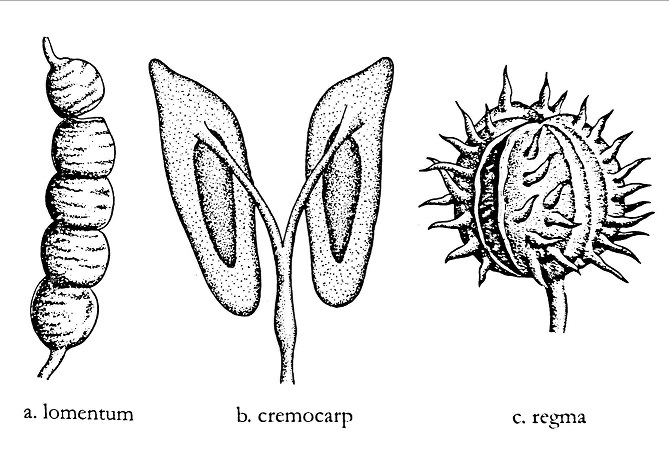
- Fruit is a characteristic feature of all the flowering plants (angiosperms) which usually develops after fertilization.
- In some plants fruits may develop without fertilization. Such fruits are called parthenocarpic fruits.
- Fruits are of two types:
- True fruit: It develops only from the ovary of the flower.
- False fruit: The development of such fruits involves other floral members.
- The fruit wall or the pericarp is usually differentiated into three layers; an outer epicarp, a middle mesocarp and an inner endocarp.
- Fruits are usually classified into three groups;
- Simple
- Aggregate
- Multiple
- Simple fruits are further classified into three types; dehiscent, indehiscent and fleshy.
1. Dry dehiscent fruits:
- These fruits burst open automatically on ripening and discharge their seeds.
- Their mode of dehiscence differs greatly. Dehiscent fruits may be of the following types:

a. Legume or pod:
- This develops from a superior, monocarpellary, unilocular ovary and is characteristic of the leguminosae family. The fruit splits along both the sutures.
b. Siliqua:
- This develops from a bicarpellary superior ovary and is a characteristic of the cruciferae family.
- The dehiscence takes place along both the sutures from base to apex while seeds remain attached to the false partition wall, the replum.
- Siliqua is a short and flattened silicula as in candytuft (berries).
c. Follicle:
- It develops from bicarpellary gynoecium and unilocular ovary and the dehiscence occurs by one half. E.g. Calotropis
d. Capsule:
- It develops from superior, syncarpous, multilocular ovary. The dehiscence occurs by;
- By pore: Poricidal e.g. Opium
- By locules: Loculicidal e.g. Cotton, Lady’s finger
- By septa: Septicidal e.g. Linum
- By septa breaking into fragments: Septifragal g. Datura
2. Dry indehiscent fruits:
- Such fruits never dehisce. The pericarp is dry. It may be of the following types:

a. Caryopsis:
- It develops from bicarpellary gynoecium and unilocular ovary.
- It is a characteristic feature of the grass family (graminae). The pericarp is fused with the seed coat.
b. Cypsela:
- It develops from bicarpellary gynoecium. It is the characteristic feature of family compositae.
- In contrast to caryopsis, the pericarp is free from the seed coat and bears persistent hairy pappus.
c. Nut:
- This is one-chambered, one seeded fruit which develops from superior multicarpellary ovary and has usually a hard and woody pericarp. E.g. Cashew nut, Litchi.
d. Achene:
- It develops from bicarpellary to multicarpellary gynoecium. It is a small one seeded fruit with pericarp free from coat. E.g. rose
e. Samara:
- It is a one or two seeded winged fruit. Wings develop from pericarp.
- The mature fruit separates into two parts each enclosing a seed. E.g. Dioscorea, Shorea
3. Dry schizocarpic fruit:

a. Lomentum:
- It is a constricted legume. The septa develop between the seeds into many one seeded structures. At maturity, fruit splits up into one-seeded structures. E.g. Acacia
b. Cremocarp:
- It develops from bicarpellary gynoecium. At maturity, fruit splits up into two one-seeded structures attached at carpophore. Each one seeded structure is called a mericarp. E.g. Coriander, Carrot.
c. Regma: It develops from tricarpellary gynoecium.
4. Fleshy or edible fruits:
- Fleshy fruits usually remain succulent and juicy even when fully mature. These are of the following types:

a. Drupe:
- This is normally one-seeded fruit with its pericarp well differentiated into an outer skin-like epicarp and an inner stony hard endocarp. E.g. Mango, Coconut, Peach
b. Berry:
- This term is applied to any fleshy fruit in which there is no hard part except the seeds. Seeds are embedded in the pulp formed from the various layers of the fruit wall. E.g. Egg plant, Tomato, Banana.
c. Pepo:
- This is like a berry but develops from an interior, multicarpellary and syncarpous ovary with parietal placentation as in Cucurbits. E.g.Cucumber, Watermelon.
d. Hesperidium:
- This is also like a berry, but it develops from a multicarpellary and syncarpous pistil with axile placentation.
- Here, the epicarp and the mesocarp form a leathery skin, while the endocarp pojects inwards forming distinct chambers with juicy haris. e.g. Orange, Lemon.
e. Pome:
- This is false fruit as it is surrounded by a fleshy and edible thalamus. It develops from an inferior, multicarpellary and syncarpous ovary. E.g. Apple, Pear.
f. Balausta:
- It develops from multicarpellary gynoecium, many chambered, epicarp fused with thalamus to form outer hard covering (rivel) and inner wall projects inward and covers the chambers. E.g. Pomegranate. At maturity the fruit splits up into three one- seeded structures known as cocci. E.g. Euphorbia
g. Double samara:
- It develops from bicarpellary gynoecium. At maturity, the fruit splits up into two samaras. E.g. Acer
h. Carcerulur:
- It develops from bicarpellary gynoecium. At maturity, the fruit splits up into four one-seeded structures. E.g. Ocimum.